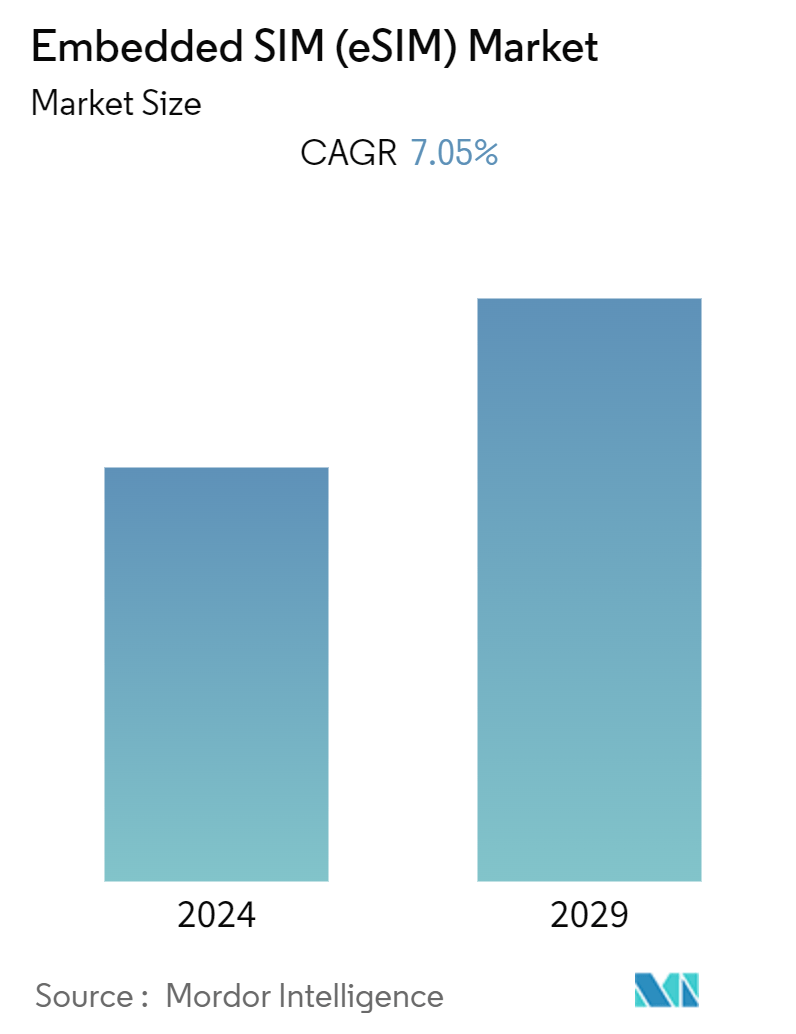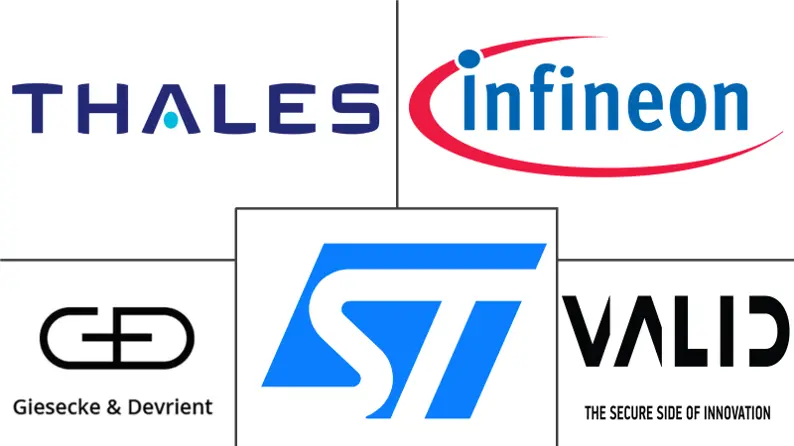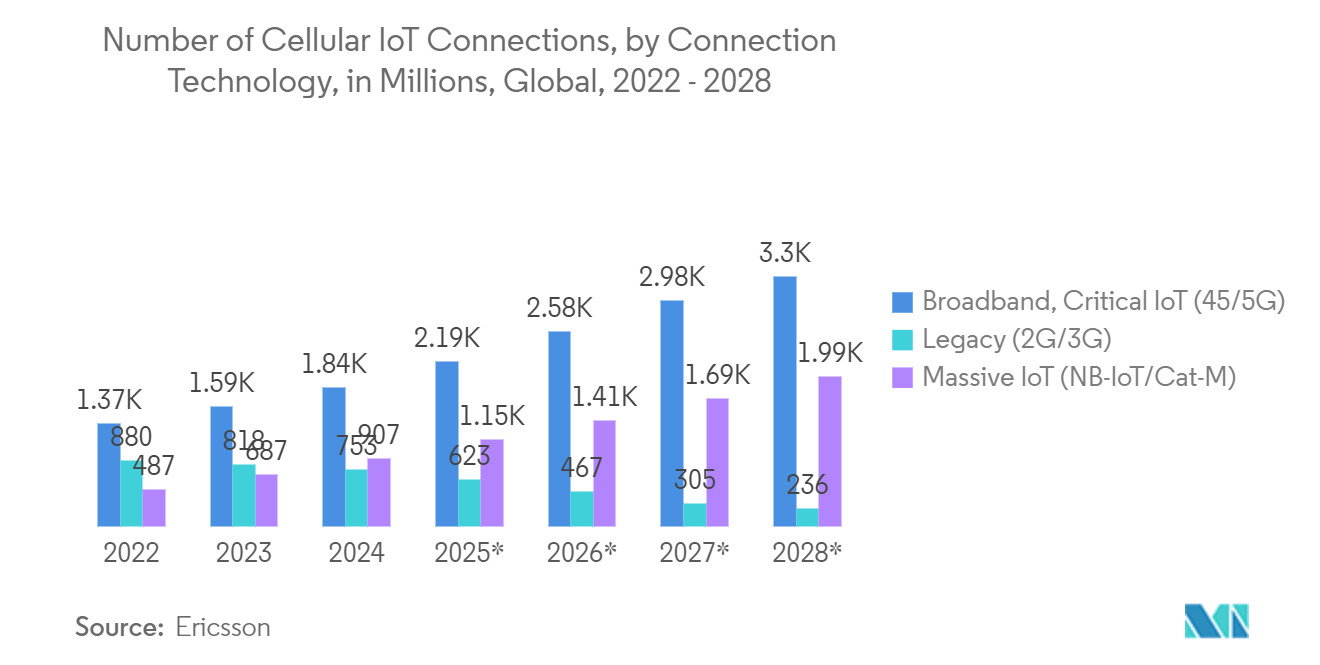Embedded SIM (eSIM) Market Size

| Study Period | 2019 - 2029 |
| Base Year For Estimation | 2023 |
| CAGR (2024 - 2029) | 7.05 % |
| Fastest Growing Market | Asia Pacific |
| Largest Market | North America |
| Market Concentration | Low |
Major Players
*Disclaimer: Major Players sorted in no particular order |
Embedded SIM (eSIM) Market Analysis
The Embedded SIM Market is expected to register a CAGR of 7.05% during the forecast period.
An eSIM is a small, programmable chip embedded directly into devices, such as smartphones, tablets, wearable devices, and other IoT devices, allowing remote SIM provisioning without needing a physical SIM card.
- The Internet of Things (IoT) was one of the key drivers for eSIM adoption. As the number of connected devices increased, managing physical SIM cards for each device became impartial. eSIM provided a scalable solution for deploying and managing IoT devices globally.
- Advancements in the connected and M2M (machine-to-machine) ecosystem were key drivers in the market's growth. The growth of the 5G network also creates new opportunities for eSIM adoption. Enterprises embraced eSIM for their M2M deployments, such as asset tracking, smart meters, industrial monitoring, and supply chain management.
- The growing demand for smart devices was one of the key drivers that increased the adoption of eSIM technology. Smart devices, including smartphones, tablets, wearables, connected cars, and various Internet of Things (IoT) devices, have become more prevalent in consumer and industrial applications.
- Security and interoperability standardization issues are restraining the market growth. With traditional SIM cards, physical access is required to tamper with or replace the SIM, making it more difficult for malicious actors to compromise the connection. However, as eSIM is soldered directly onto the device's circuitry, the potential for unauthorized access or cloning could be a significant security risk.
Embedded SIM (eSIM) Market Trends
Smartphones Application Segment is Expected to Hold Significant Market Share
- eSIM technology has been increasingly integrated into smartphones, bringing numerous benefits to consumers and mobile network operators (MNOs). eSIM eliminates the need for physical SIM cards, allowing users to activate and switch between mobile carriers more easily. With eSIMs, users can remotely provision their devices with a new carrier's profile without the hassle of acquiring a physical SIM card and waiting for it to be delivered.
- eSIM technology has enabled the adoption of dual-SIM functionality in smartphones. With a combination of eSIM physical card slots, users can have two active phone numbers on the same devices, which is especially useful for travelers, business professionals, or people with multiple cellular subscriptions.
- For mobile network operators, eSIM technology offers greater flexibility in onboarding new customers. Instead of distributing physical SIM cards through retail channels, MNOs can remotely provision eSIMs, simplifying the activation process and reducing distribution costs.
- eSIM plays a significant role in enabling connectivity for IoT devices. Smartphones are a gateway for various IoT applications, and eSIM technology provides a secure and efficient way to connect IoT devices to cellular networks.
- The ongoing development of 5G networks and the proliferation of IoT devices are expected to further the integration of eSIM in smartphones and other connected devices. According to Ericsson, the number of cellular IoT connections with critical IoT and broadband globally in 2022 was approximately 1.5 billion. In five years, the forecast is that the number of cellular IoT connections with the same connection type will continue to rise steadily each year, up to 3.3 billion.

North America is Expected to Hold Significant Market Share
- North America has witnessed a rapid rise in the adoption of IoT devices across various industries, including healthcare, automotive, smart home, and industrial applications. eSIM technology plays a crucial role in providing seamless connectivity for these devices, driving the growth of the eSIM market.
- Manufacturers have incorporated eSIM technology into many devices, including smartphones, tablets, wearables, and IoT devices. As more devices become eSIM-enabled, the demand for eSIM services is expected to rise.
- The deployment of 5G networks in North America has been gaining momentum. eSIM technology complements the capabilities of the 5G network by providing seamless connectivity and making it easier for consumers to switch between carriers and plans. According to Cisco Systems, North America will have the most 5G connections made using wearable devices in 2022. The 439 million connections in North America would be 222 million more than those made to 4G networks in 2017.
- The plans related to eSIM becoming significantly cheap in the region and a secure international roaming solution considerably drive the adoption of eSIM in the region. On phones with eSIM support, the user can select from several individual countries or roaming plans, where the multi-country operators tend to be significantly more expensive than US Mobile's solution. If the user is traveling abroad, he can select the carrier's roaming plan. The user can also buy a local SIM card or a multi-country travel SIM card like KnowRoaming, which is the most expensive. eSIM lets the user scan a QR code or pick a new carrier from an on-device menu, making it much easier to switch carriers or roam.
- In December 2022, Grover, one of the top subscription providers for consumer technology, unveiled Grover Connect, an MVNO for clients renting technology in the United States. The country clients can quickly activate any eSIM-enabled technology gadget using Grover Connect. Also, Grover partnered with Gigs, one of the global leaders in telecom-as-a-service platforms in the world that enables any business or brand to become an MVNO, to introduce this innovative new offering. Customers can purchase a Grover eSIM at checkout in the United States, which will soon be available in its European regions.

Embedded SIM (eSIM) Industry Overview
The embedded SIM (eSIM) market is fragmented, with the presence of major players like Gemalto N.V. (Thales Group), Giesecke+Devrient GmbH, STMicroelectronics N.V., Infineon Technologies AG, and Valid S.A. Players in the market are adopting strategies such as partnerships and acquisitions to enhance their product offerings and gain sustainable competitive advantage.
In February 2023, Giesecke+Devrient (G+D) and its partner NetLync launched AirOn360 ES, enabling Mobile Network Operators to deploy Entitlements, including the seamless SIM transfer on iPhone from physical SIM card or eSIM, allowing mobile operators to offer convenient services such as simplified and digital activation processes, synchronization of all devices, or (e)SIM transfers. For users, eSIM allows them to easily connect or quickly transfer their existing plans digitally and provides for multiple cellular plans on a single device.
In November 2022, STMicroelectronics collaborated with Thales, which powers secure, contactless convenience in Google Pixel 7. The ST54K single-chip NFC controller and secure element combine with Thales secure OS for superior performance in embedded SIM, transit ticketing, and digital car-key applications.
Embedded SIM (eSIM) Market Leaders
-
Gemalto N.V. (Thales Group)
-
Giesecke+Devrient GmbH
-
STMicroelectronics N.V.
-
Infineon Technologies AG
-
Valid S.A.
*Disclaimer: Major Players sorted in no particular order
_Market_Concentration.webp)
Embedded SIM (eSIM) Market News
- March 2023: Thales, one of the global leaders in eSIM management, supports the growth of eSIM-enabled consumer and industrial devices with Google Cloud expertise. Thales' pioneering Cloud solution combines its security assets with Google's cloud presence in 200 countries to provide enhanced security, flexibility, and service availability to MNOs.
- November 2022: Mobilise, a developer in eSIM as a Service and a telecom software supplier, has launched its eSIM software development kit (SDK) in response to the increased demand for digital services from service providers (SPs) and their clients. The SDK enables SPs to provide clients with global connections within their current application, including an in-app eSIM activation feature.
- November 2022: In Korea, Samsung launched its eSIM-capable smartphones, the Galaxy Z Fold4 and Flip4. Korean carriers began to enable eSIM smartphone activation, ushering in a new mobile era in Korea. From eSIM V1 to V3, Samsung Research actively participated in and led the GSMA eSIM standardization process. It also significantly contributed to the successful commercialization of Samsung eSIM devices.
- September 2022: The software-defined end-to-end eSIM ecosystem has been released in beta by innovative software company RiPSIM Technologies, Inc., enabling wireless service providers and enterprise network operators to become independent of conventional SIM card producers. Customers may produce and download eSIMs in minutes rather than months owing to RiPSIM's technology, and they can benefit from a disruptive business model devoid of inefficient operations and expensive transactions.
Embedded SIM (eSIM) Market Report - Table of Contents
1. INTRODUCTION
- 1.1 Study Assumptions and Market Definition
- 1.2 Scope of the Study
2. RESEARCH METHODOLOGY
3. EXECUTIVE SUMMARY
4. MARKET INSIGHTS
- 4.1 Market Overview
- 4.2 Industry Stakeholder Analysis Operator, OEM & System Integrators
-
4.3 Industry Attractiveness - Porter's Five Forces Analysis
- 4.3.1 Bargaining Power of Suppliers
- 4.3.2 Bargaining Power of Consumers
- 4.3.3 Threat of New Entrants
- 4.3.4 Threat of Substitute Products
- 4.3.5 Intensity of Competitive Rivalry
- 4.4 Impact of COVID-19 on the Connectivity Landscape
- 4.5 Coverage on e-SIM Enabled Device Shipments Globally
5. MARKET DYNAMICS
6. Market Drivers
- 6.1 Advancements in the Field of Connected & M2M Ecosystem
- 6.2 Growing Demand for Smart Devices
- 6.3 Ease of Use and Access Provided by eSIM over Traditional Substitutes
7. Market Challenges
- 7.1 Security, Interoperability Standardization Issues
8. Market Opportunities
- 8.1 Highly Positive Forecasts for M2M Adoption
9. GLOBAL SIM CARD LANDSCAPE ANALYSIS (SHIPMENTS & REGIONAL BREAKDOWN)
10. MARKET SEGMENTATION
-
10.1 By Application
- 10.1.1 Smartphones
- 10.1.2 Tablets & Laptops
- 10.1.3 Wearables
- 10.1.4 M2M (Industrial, Automotive, etc.)
-
10.2 By Geography***
- 10.2.1 North America
- 10.2.1.1 United States
- 10.2.1.2 Canada
- 10.2.2 Europe
- 10.2.2.1 United Kingdom
- 10.2.2.2 Germany
- 10.2.2.3 France
- 10.2.3 Asia
- 10.2.3.1 China
- 10.2.3.2 South Korea
- 10.2.3.3 Japan
- 10.2.3.4 Australia and New Zealand
- 10.2.4 Latin America
- 10.2.5 Middle East and Africa
11. COMPETITIVE LANDSCAPE
-
11.1 Company Profiles*
- 11.1.1 Gemalto N.V. (Thales Group)
- 11.1.2 Giesecke+Devrient GmbH
- 11.1.3 STMicroelectronics N.V.
- 11.1.4 Infineon Technologies AG
- 11.1.5 Valid S.A.
- 11.1.6 Idemia (Advent International Corp)
- 11.1.7 Workz Group
- 11.1.8 Truphone Limited
- 11.1.9 Gigsky, Inc.
- 11.1.10 ARM Limited
12. VENDOR POSITIONING ANALYSIS
13. MARKET OUTLOOK
** Subject To AvailablityEmbedded SIM (eSIM) Industry Segmentation
The Embedded SIM/eSIM, also known as embedded Universal Integrated Circuit Card (eUICC), is smaller again at 6 mm in length and 5 mm in width and is soldered onto a motherboard of the device during manufacturing and has the same functionality as a removable SIM. It has Remote Provisioning and M2M (machine-to-machine) capabilities.
The Embedded SIM (eSIM) market is segmented by application (smartphones, tablets and laptops, wearables, M2M), by geography (North America (United States, Canada), Europe (United Kingdom, Germany, France, rest of Europe), Asia Pacific (China, South Korea, Japan, rest of Asia Pacific), Latin America, Middle East and Africa).
The market sizes and forecasts are provided in terms of value USD for all the above segments.
| By Application | Smartphones | |
| Tablets & Laptops | ||
| Wearables | ||
| M2M (Industrial, Automotive, etc.) | ||
| By Geography*** | North America | United States |
| Canada | ||
| By Geography*** | Europe | United Kingdom |
| Germany | ||
| France | ||
| By Geography*** | Asia | China |
| South Korea | ||
| Japan | ||
| Australia and New Zealand | ||
| By Geography*** | Latin America | |
| Middle East and Africa |
Embedded SIM (eSIM) Market Research FAQs
What is the current Embedded SIM (eSIM) Market size?
The Embedded SIM (eSIM) Market is projected to register a CAGR of 7.05% during the forecast period (2024-2029)
Who are the key players in Embedded SIM (eSIM) Market?
Gemalto N.V. (Thales Group), Giesecke+Devrient GmbH, STMicroelectronics N.V., Infineon Technologies AG and Valid S.A. are the major companies operating in the Embedded SIM (eSIM) Market.
Which is the fastest growing region in Embedded SIM (eSIM) Market?
Asia Pacific is estimated to grow at the highest CAGR over the forecast period (2024-2029).
Which region has the biggest share in Embedded SIM (eSIM) Market?
In 2024, the North America accounts for the largest market share in Embedded SIM (eSIM) Market.
What years does this Embedded SIM (eSIM) Market cover?
The report covers the Embedded SIM (eSIM) Market historical market size for years: 2019, 2020, 2021, 2022 and 2023. The report also forecasts the Embedded SIM (eSIM) Market size for years: 2024, 2025, 2026, 2027, 2028 and 2029.
Embedded SIM (eSIM) Industry Report
Statistics for the 2024 Embedded SIM (eSIM) market share, size and revenue growth rate, created by Mordor Intelligence™ Industry Reports. Embedded SIM (eSIM) analysis includes a market forecast outlook 2029 and historical overview. Get a sample of this industry analysis as a free report PDF download.



